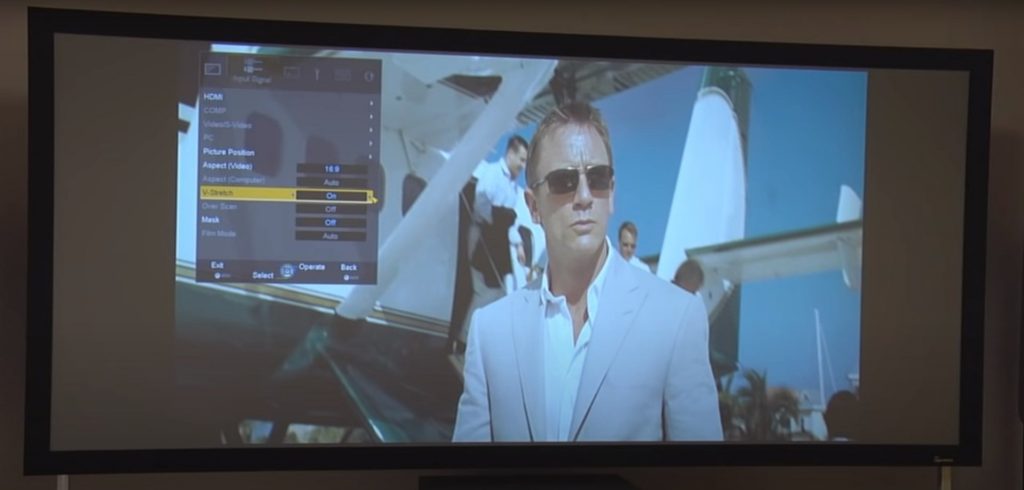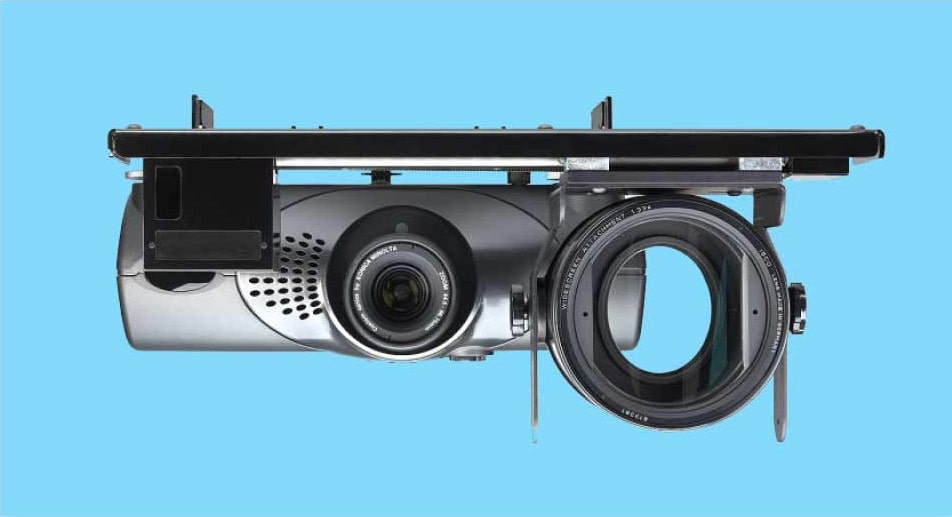Do you want to enjoy movies on an ultra-widescreen?
Careful investments and efforts are essential to set up a widescreen home theatre that creates an immersive and cinema-style viewing experience.
CInephiles are using modern high-end projectors in a thoughtfully designed room to watch movies on a massive screen.
But is it even possible to take the widescreen cinema out of the cinema hall and take it to your living room?
In this article, we will discuss Anamorphic Lens for projector, one of those equipments that help you set up your own ultra-wide screen theatre at home.
People started using them over a decade ago. But are they useful in 2024?
This question needs to be answered with proper justification.
Now without any further ado, let’s start.
Quick Overview of Anamorphic Lens for Projector

This unique lens is responsible for making the appearance of a video or movie from good to great. It is mainly used to avoid annoying black empty spaces or letterboxes on the screen.
The exorbitant cost of an Anamorphic Lens makes it beyond the affordability for the average consumer. Apart from the price, the complexity of the shape of the anamorphic lens and being used as an additional accessory became a significant thing to consider.
They cost almost the same as an entire projector system, and carrying an additional lens along with the projector proved to be a cumbersome affair. Panamorph is a popular brand when it comes to anamorphic lenses.
Some of the best Anamorphic Lens Kits for Projector that you can buy in 2024 are,
- Paladin DCR + XM2 – Price $8,995
- DCR-S1, DCR-S2 (Sony) & DCR-J1 (JVC) – Price $5,995
- RSLA2 – ANAMORPHIC LENS (SCHNEIDER) – Price $8325
- Epson ELPFALKED Panamorph – Price $2995
- Paladin + XM2 – Price $6,995
Before we proceed further in this article, let us understand a vital terminology that you must understand properly.
Aspect Ratio – How does it affect the viewing experience?
Movies are offered in a variety of shapes, often called aspect ratios.
The aspect ratio is the width to height ratio (W:H) of a screen. There are eight Film and TV aspect ratios as below,
- 4:3
- 16:9
- 1.85:1
- 2.39:1
- 2.76:1 (70mm)
- 1.37:1 (Academy Ratio)
- 2.59:1 (Cinerama)
- 2.35:1 (Cinemascope)

Initially, an aspect ratio of 4:3 was used for producing a silent 35mm film. Later, when a soundtrack was merged with the film, it evolved to a 1:17:1 and a 16:9 ratio to create a widescreen or HD quality picture.
Not all of these eight aspect ratios are popular in 2024 except the 16:9 ratio. The 16:9 ratio movie on an HD TV screen has been top-rated over the last few years. HD TVs are also known as widescreen or scope screens because their width is twice as long as height.
So 4:3 and 16:9 are universal videographic aspect ratios for high-definition television.
In fact, the size of most of the television screens and projector screens are designed to support the 16:9 ratio. Also, famous projectors with a native resolution of 1080p support an aspect ratio of 16:9.
Advancements in aspect ratio technology led to a wider picture using the 2.35:1 ratio or known as the anamorphic format was introduced to replace the 16:9 aspect ratio, which is popularly known as ‘Cinemascope’.
If you are a cinephile, then the 16:9 aspect ratio is not the best fit for you. The Cinemascope ratio (2.35:1) will impress you. It is a super widescreen format developed by 20th Century Fox. It is mainly used in cinema halls with a huge widescreen.
However, screens and displays used in the home are not compatible with the 2.35:1 aspect ratio. So, on a typical television or projector screen, ultra-wide movies are shown with black bars. Ex. When a movie with an aspect ratio of 2.35:1 is shown on a 16:9 ratio display.

To enjoy a 2.35:1 aspect ratio movie, you need an excellent projector, anamorphic lens and a 2.35:1 projector screen. But note that having this equipment is not sufficient; you also need to have the knowledge of CIH (Constant Image Height) projection and steps to achieve CIH.
The following section will briefly cover CIH and methods of eliminating the black bars or letterboxes.
Now, let’s discuss what CIH? and how it helps you set up an ultra-widescreen movie theatre.
What is CIH Projection?
CIH stands for Constant Image Height. It is a method of eliminating the black bars or letterboxes.
Letterboxes are nothing but unused pixels of the screen.
To utilize these unused pixels, it was obvious that the picture needed to be stretched vertically and horizontally. It can be achieved using,
#1 – Lens Memory System
In this method, the projector simply changes the zoom and picture position. The lens memory method requires no additional lens meaning that your money will be saved. However, this feature is not available in most entry-level projectors. You need to purchase a high-end projector from brands like JVC & Sony.
This method is mainly used for projecting 16:9 content on a widescreen (2.35:1 aspect ratio).
In this case, the projector does some additional processing or manipulation like cropping or condensing the original images to fit the screen. Images, in this case, are altered and can leave an undesired effect.
Brightness or Lumens also gets affected by zooming in or out digitally.
Honestly, this is not the most efficient way of setting up the widescreen. That’s where the anamorphic lens can help, so let us discuss them in the following section.
#2 – Additional Anamorphic Lens
Using an anamorphic lens to avoid black bars has some added advantages.
A large lens is placed in front of the projector existing lens. Whenever the broadcast involved a different ratio than the 2.35:1 aspect ratio, this lens could be removed manually or by a motorized mechanism. The result produced a clear picture with optimum height, although the width was variable.
In this method, the 2.35:1 image first needs to be stretched vertically and then horizontally to fill up the entire screen.
Consider the following image in which a 2.35:1 image is projected on a 2.35:1 screen. You will notice black bars around the actual image.

Consider if instead of a 2.35:1 screen, we could be using a 16:9 HDTV screen, then we could have noticed the black bars only at the top and bottom of the image. In other words, 2.35:1 is an ultra-widescreen where you will notice black bars on the left and right of the screen.
Now, let us discuss how we can eliminate these black bars in two steps.
Step #1: An electronics processing (zooming) is used to stretch the image vertically. Though this vertical stretching eliminates upper and lower black bars, it creates a distorted image that doesn’t look good at all. This distortion is known as fanhouse-mirror imaging.

Step #2: Further, an Anamorphic Lens is used for stretching images horizontally. After this horizontal stretching, you would see a properly proportioned 2.35:1 image on the 2.35:1 screen.

This way, you will ensure that all of the pixels from your 2.35:1 image are utilized, and CIH is achieved.
Pros and Cons of Anamorphic Lens for projector
As technology further advanced, an anamorphic lens was developed for creating an impressive movie-watching experience.
Pros
- The brightness and contrast are perfect. This is achieved by redirecting all the light from the projector onto the 2.35:1 screen.
- All pixels are used to project better images, much larger than traditional systems.
- This lens hides more of the dark borders or letterboxes by utilizing extra pixels.
- They are the perfect fit for CIH display which is the need of every Cinephile.
- Apart from 2.35:1 movies, it offers good results with the Blue-Ray videos and broadcasts with suitable aspect ratios.
Cons
- The huge initial investment in cost is a significant deterrent.
- The lens is large and not very compatible with some projectors and needs to be removed in such cases.
- There may be a spillover of the borders on the adjoining background, but not very visible.
If you have enough money to invest, then the benefits offered by the Anamorphic Lens implies that they are worth investing!
Additional spending on Anamorphic Lens will let you enjoy cinema-style movies right from your home.
Final Verdict
Initially, when images were first projected on a screen, some inherent deficiencies were noticeable. Primarily, among them was the appearance of letterboxes around the picture. A substantial amount of the display size was covered by them.
Some of these occurred on account of the primitive production and display methods used as the aspect ratios were severely compromised.
As technology advanced, the anamorphic lens was developed, which helped to display a fuller and more precise picture. Due to the complexity of the anamorphic lens, it was an expensive proposition. But as of now, there is no other way if you wish to set up an ultra-wide home theatre.
Read more of our articles




1 Comment
What is your advice on using the Lumagen or Mad VR video processor for converting 16:9 projector into anamorphic video?